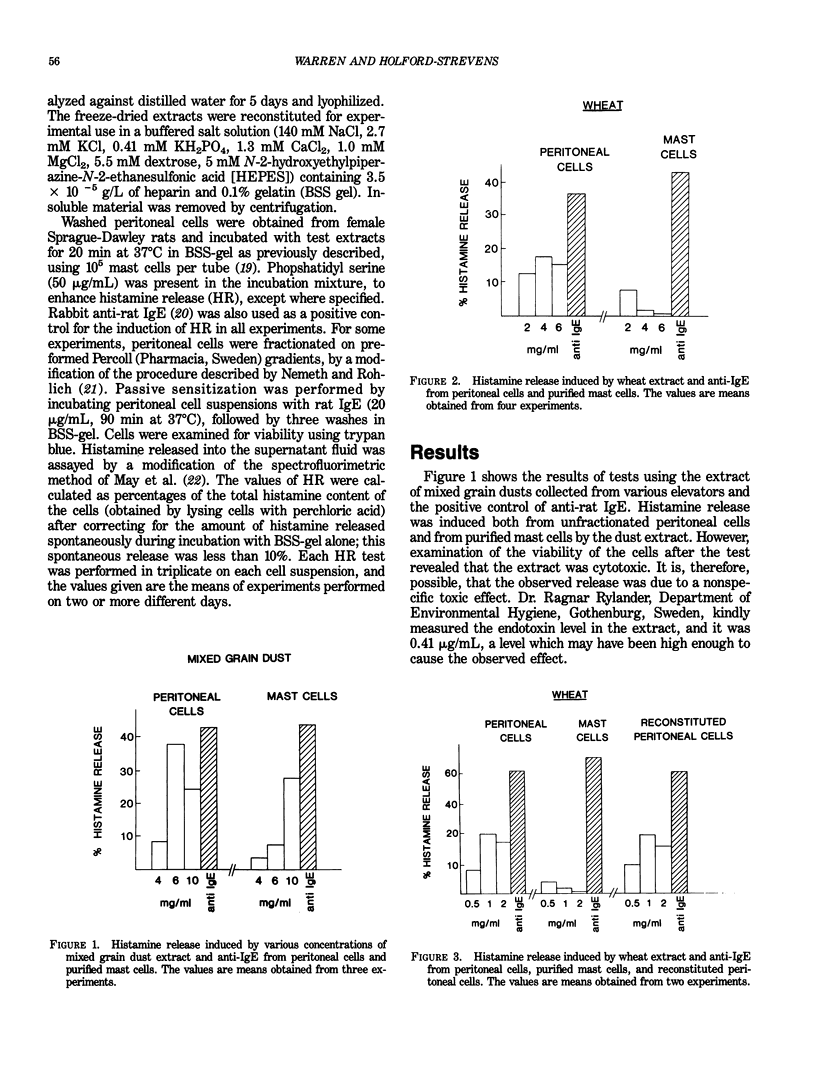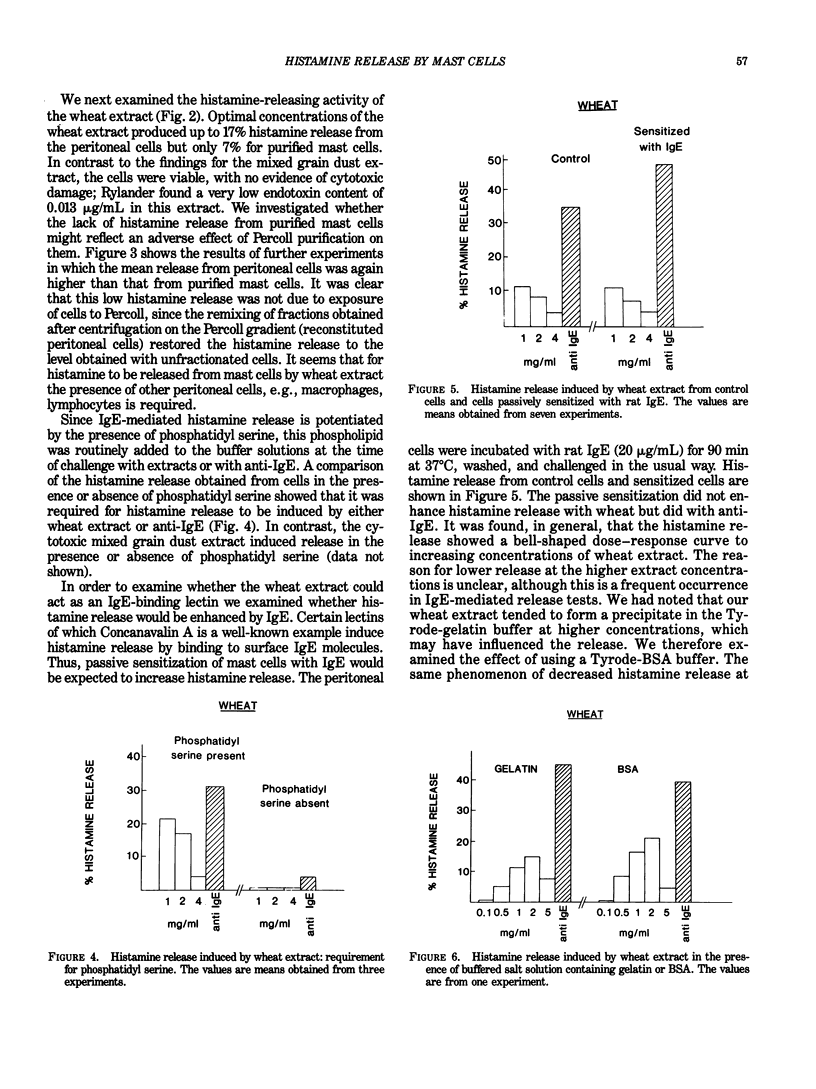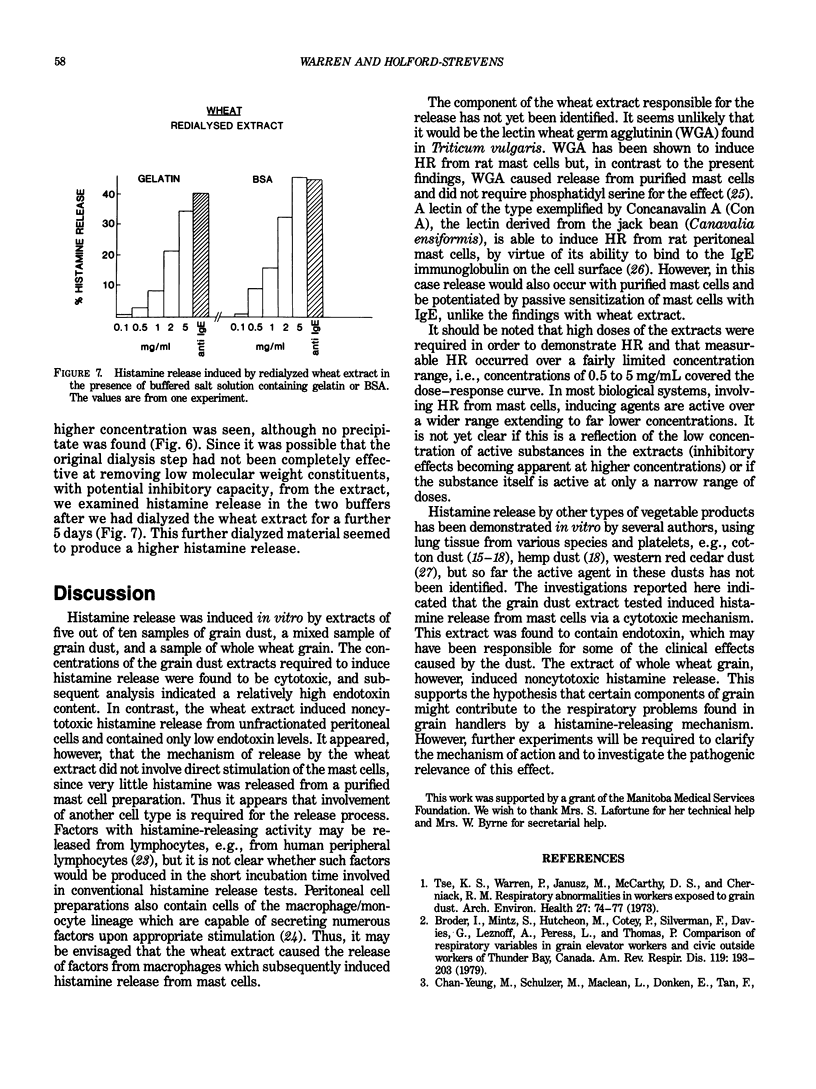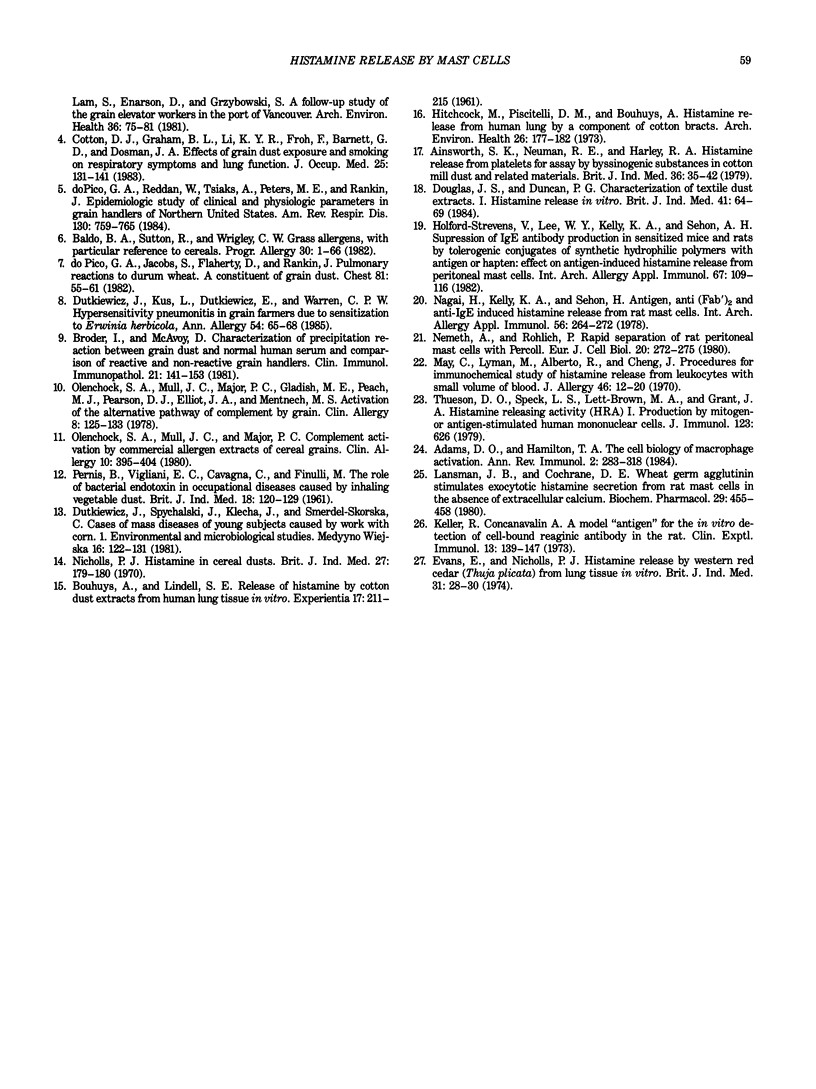Abstract
The ability of extracts of grain dust and wheat to induce histamine release from rat peritoneal cells was investigated. Some grain dusts, with a high endotoxin content, were found to produce cytotoxic histamine release. Extract of wheat dust, with a low endotoxin release, produced noncytotoxic histamine release from peritoneal cells but not from purified mast cells. This reaction was dependent on the presence of phosphatidyl serine. The agent did not appear to be a lectin because histamine release was not enhanced by passive sensitization of mast cells with IgE. The activity occurred only over a narrow range of concentrations of the extract of wheat. The cause was unclear.
Full text
PDF




Selected References
These references are in PubMed. This may not be the complete list of references from this article.
- Adams D. O., Hamilton T. A. The cell biology of macrophage activation. Annu Rev Immunol. 1984;2:283–318. doi: 10.1146/annurev.iy.02.040184.001435. [DOI] [PubMed] [Google Scholar]
- Ainsworth S. K., Neuman R. E., Harley R. A. Histamine release from platelets for assay of byssinogenic substances in cotton mill dust and related materials. Br J Ind Med. 1979 Feb;36(1):35–42. doi: 10.1136/oem.36.1.35. [DOI] [PMC free article] [PubMed] [Google Scholar]
- Baldo B. A., Sutton R., Wrigley C. W. Grass allergens, with particular reference to cereals. Prog Allergy. 1982;30:1–66. [PubMed] [Google Scholar]
- Broder I., McAvoy D. Characterization of precipitation reaction between grain dust and normal human serum and comparison of reactive and nonreactive grain handlers. Clin Immunol Immunopathol. 1981 Nov;21(2):141–153. doi: 10.1016/0090-1229(81)90203-8. [DOI] [PubMed] [Google Scholar]
- Broder I., Mintz S., Hutcheon M., Corey P., Silverman F., Davies G., Leznoff A., Peress L., Thomas P. Comparison of respiratory variables in grain elevator workers and civic outside workers of Thunder Bay, Canada. Am Rev Respir Dis. 1979 Feb;119(2):193–203. doi: 10.1164/arrd.1979.119.2.193. [DOI] [PubMed] [Google Scholar]
- Chan-Yeung M., Schulzer M., MacLean L., Dorken E., Tan F., Lam S., Enarson D., Grzybowski S. A follow-up study of the grain elevator workers in the Port of Vancouver. Arch Environ Health. 1981 Mar-Apr;36(2):75–81. doi: 10.1080/00039896.1981.10667610. [DOI] [PubMed] [Google Scholar]
- Cotton D. J., Graham B. L., Li K. Y., Froh F., Barnett G. D., Dosman J. A. Effects of grain dust exposure and smoking on respiratory symptoms and lung function. J Occup Med. 1983 Feb;25(2):131–141. [PubMed] [Google Scholar]
- Dopico G. A., Reddan W., Tsiatis A., Peters M. E., Rankin J. Epidemiologic study of clinical and physiologic parameters in grain handlers of northern United States. Am Rev Respir Dis. 1984 Nov;130(5):759–765. doi: 10.1164/arrd.1984.130.5.759. [DOI] [PubMed] [Google Scholar]
- Douglas J. S., Duncan P. G. Characterisation of textile dust extracts: I. Histamine release in vitro. Br J Ind Med. 1984 Feb;41(1):64–69. doi: 10.1136/oem.41.1.64. [DOI] [PMC free article] [PubMed] [Google Scholar]
- Dutkiewicz J., Kus L., Dutkiewicz E., Warren C. P. Hypersensitivity pneumonitis in grain farmers due to sensitization to Erwinia herbicola. Ann Allergy. 1985 Jan;54(1):65–68. [PubMed] [Google Scholar]
- Evans E., Nicholls P. J. Histamine release by Western red cedar (Thuja plicata) from lung tissue in vitro. Br J Ind Med. 1974 Jan;31(1):28–30. doi: 10.1136/oem.31.1.28. [DOI] [PMC free article] [PubMed] [Google Scholar]
- Hitchcock M., Piscitelli D. M., Bouhuys A. Histamine release from human lung by a component of cotton bracts. Arch Environ Health. 1973 Apr;26(4):177–182. doi: 10.1080/00039896.1973.10666252. [DOI] [PubMed] [Google Scholar]
- Holford-Strevens V., Lee W. Y., Kelly K. A., Sehon A. H. Suppression of IgE antibody production in sensitized mice and rats by tolerogenic conjugates of synthetic hydrophilic polymers with antigen or hapten: effect on antigen-induced histamine release from peritoneal mast cells. Int Arch Allergy Appl Immunol. 1982;67(2):109–116. doi: 10.1159/000232999. [DOI] [PubMed] [Google Scholar]
- Keller R. Concanavalin A, a model "antigen" for the in vitro detection of cell-bound reaginic antibody in the rat. Clin Exp Immunol. 1973 Jan;13(1):139–147. [PMC free article] [PubMed] [Google Scholar]
- Lansman J. B., Cochrane D. E. Wheat germ agglutinin stimulates exocytotic histamine secretion from rat mast cells in the absence of extracellular calcium. Biochem Pharmacol. 1980 Feb;29(3):455–458. doi: 10.1016/0006-2952(80)90529-8. [DOI] [PubMed] [Google Scholar]
- May C. D., Lyman M., Alberto R., Cheng J. Procedures for immunochemical study of histamine release from leukocytes with small volume of blood. J Allergy. 1970 Jul;46(1):12–20. doi: 10.1016/0021-8707(70)90056-0. [DOI] [PubMed] [Google Scholar]
- Nagai H., Kelly K., Sehon A. H. Antigen-, anti-F(ab')2- and anti-IgE-induced histamine release from rat mast cells. Int Arch Allergy Appl Immunol. 1978;56(3):264–272. doi: 10.1159/000232030. [DOI] [PubMed] [Google Scholar]
- Nicholls P. J. Histamine in cereal dusts. Br J Ind Med. 1970 Apr;27(2):179–180. doi: 10.1136/oem.27.2.179. [DOI] [PMC free article] [PubMed] [Google Scholar]
- Németh A., Röhlich P. Rapid separation of rat peritoneal mast cells with Percoll. Eur J Cell Biol. 1980 Feb;20(3):272–275. [PubMed] [Google Scholar]
- Olenchock S. A., Mull J. C., Major P. C. Complement activation by commercial allergen extracts of cereal grains. Clin Allergy. 1980 Jul;10(4):395–404. doi: 10.1111/j.1365-2222.1980.tb02122.x. [DOI] [PubMed] [Google Scholar]
- Olenchock S. A., Mull J. C., Major P. C., Gladish M. E., Peach M. J., 3rd, Pearson D. J., Elliott J. A., Mentnech M. S. Activation of the alternative pathway of complement by grain. I. C3PA conversion and quantification of complement consumption by rye. Clin Allergy. 1978 Mar;8(2):125–133. doi: 10.1111/j.1365-2222.1978.tb00457.x. [DOI] [PubMed] [Google Scholar]
- PERNIS B., VIGLIANI E. C., CAVAGNA C., FINULLI M. The role of bacterial endotoxins in occupational diseases caused by inhaling vegetable dusts. Br J Ind Med. 1961 Apr;18:120–129. doi: 10.1136/oem.18.2.120. [DOI] [PMC free article] [PubMed] [Google Scholar]
- Thueson D. O., Speck L. S., Lett-Brown M. A., Grant J. A. Histamine-releasing activity (HRA). I. Production by mitogen- or antigen-stimulated human mononuclear cells. J Immunol. 1979 Aug;123(2):626–632. [PubMed] [Google Scholar]
- Tse K. S., Warren P., Janusz M., McCarthy D. S., Cherniack R. M. Respiratory abnormalities in workers exposed to grain dust. Arch Environ Health. 1973 Aug;27(2):74–77. doi: 10.1080/00039896.1973.10666321. [DOI] [PubMed] [Google Scholar]
- doPico G. A., Jacobs S., Flaherty D., Rankin J. Pulmonary reaction to durum wheat; a constituent of grain dust. Chest. 1982 Jan;81(1):55–61. doi: 10.1378/chest.81.1.55. [DOI] [PubMed] [Google Scholar]


